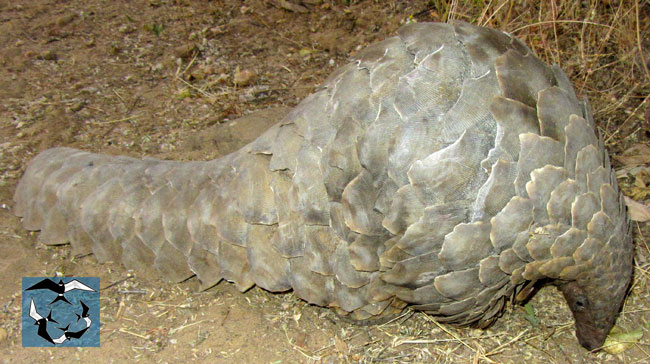![]() Pangolin remains a threatened species
Pangolin remains a threatened species
[The Namibian
— 13 February 2013]
International pangolin day is celebrated on the third Saturday of February, the 16th this year. The use of the word celebration is somewhat inaccurate for a family of animals that are the target of an enormous amount of illegal trafficking. And attached to poaching there are of course some serious allegations on the shocking conditions concerning welfare of these timid and harmless yet useful animals. Namibia recorded a number of pangolin incidents over the past year including confiscations by authorities and rescues of pangolin escapees found in urban environments. When considering the illegal activities occurring globally and whether local incidents are linked to larger trafficking event or not, our authorities need to be on high alert.
Namibia
is host to only one of four pangolin species in Africa, one of eight in
the world. Smutsia temminckii, the African ground pangolin has
a range across a number of african countries, and for that reason, widespread
occurrence, the IUCN (International Union for Conservation of Nature)
has listed this animal as an Appendix 11 “least concern”.
This listing allows some trade of skins or scales under CITES (Convention
for International Trade in Endangered Species) export and import licenses,
though nearly all the african countries where pangolins occur have national
legislation, regulation and policy that would deny permits for any and
all trade. The IUCN listing can create problems of control, because permits
are much more readily and easily falsified when authentic copies are permissible.
The extent of illegal trafficking in wildlife species is realized by authorities
worldwide. Enormous consignments, up to 23 tons, of whole frozen pangolins,
skins and scales have been uncovered in a number of incidents in Asia
in recent years. These consignments of mostly asian pangolin species including
two listed as endangered under CITES, were en route to markets in China.
Our concern is on recent consignments found with african pangolins or
pangolin parts, though these could be from any of the 4 african species.
The warning signs are there, human populations are increasing, natural
habitats are being reduced and if trade goes on unchecked the african
pangolin species will no doubt land in the same endangered category as
the asian species.
International concern for the health of wildlife populations has been dominated by the shocking events of rhino poaching especially in southern Africa, including one known recent incident in Namibia. Although overshadowed by the more conspicuous species, the plight of asian pangolins and the extent of the illegal trade is critical. Africa needs to take heed and be sure that not only advocacy but information on policies concerning illegal hunting , trade and animal welfare are in place. Our concern and support must be given to port and border authorities who require the capacity to fully investigate all consignments leaving Namibia. The pangolin plight has been taken up by a Species Specialist Group, mandated under CITES, of which Namibia is a ratified member, but we need all citizens to actively engage in halting activities that threaten our heritage.

Advocacy needs to define strong deterrents for any pangolin use. Information needs to go to civil society especially farmers and to public officers including officers from the police and the Ministries of Environment and Tourism, Agriculture Water and Forestry and Health and Social Services. The Ministry of Agriculture Water and Forestry because they are mandated to monitor developments in bush clearing for charcoal production, can facilitate the identification of persons who scour areas of Namibian land and must be finding all sorts of wildlife, including pangolins. The Ministry of Heath and Social Services is mandated with the registration and perhaps to some extent control of traditional healers in Namibia who use pangolin parts in unverified cures as well as simply for luck.
Africa and definitely Namibia has to deal with multi-cultural value systems. With the rapid increase in global trade and the influx of foreign nationals a number of extra protective measures will need to be put in place in order to guarantee the safety of national standards, resources and heritage. The 16th of February is International Pangolin day, however protection is needed every day from illegal and unethical poaching and trade.
To date Namibia has little information on both the distribution and the density of our pangolin population. A data-base on sightings of pangolin in Namibia would be useful to feed to a larger regional group of pangolin scientists and conservationists. We can take action and in a public role of citizen scientists, report on sightings and on any wildlife activities that are endangering an individual animal or a species.
 Liz
Komen
Liz
Komen
NARREC